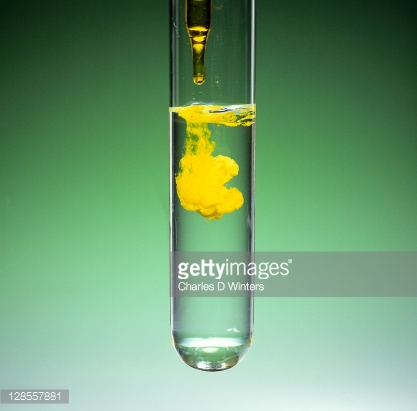Question #a9f4f
1 Answer
Here's what I got.
Explanation:
Since you didn't provide the concentration of the lead(II) nitrate solution, we're going to have to improvise a bit here.
You're dealing with a double replacement reaction in which aqueous potassium chromate,
The balanced chemical equation that describes this reaction looks like this
#"K"_ 2"CrO"_ (4(aq)) + "Pb"("NO"_ 3)_ (2(aq)) -> "PbCrO"_ (4(s)) darr + 2"KNO"_(3(aq))#
Notice that the two reactants react in a
Moreover, lead(II) chromate is produced in the same
Use the molarity and volume of the potassium chromate solution to find how many moles of this reactant you have present
#color(purple)(|bar(ul(color(white)(a/a)color(black)(c = n_"solute"/V_"solution" implies n_"solute" = c * V_"solution")color(white)(a/a)|)))#
In your case, you have
#n_(K_2CrO_4) = "0.40 mol" color(red)(cancel(color(black)("L"^(-1)))) * overbrace(15.0 * 10^(-3)color(red)(cancel(color(black)("L"))))^(color(blue)("volume in liters"))#
#n_(K_2CrO_4) = "0.00600 moles K"_2"CrO"_4#
Now, you have three possible scenarios to account for here
- If you have fewer moles of lead(II) nitrate than moles of potassium chromate
In this case, lead(II) nitrate will be the limiting reagent because it will be completely consumed by the reaction before all the moles of potassium chromate will get the chance to react.
#n_(Pb(NO_3)_2) < "0.00600 moles"#
Since you have equal volumes of both solutions, you can say that if the concentration of the lead(II) nitrate is lower than that of potassium chromate, the former will act as a limiting reagent.
#color(green)(|bar(ul(color(white)(a/a)color(black)(c_(Pb(NO_3)_2) color(red)(<) "0.40 mol L"^(-1))color(white)(a/a)|))) -># lead(II) nitrate will be the limiting reagent
- if you have equal numbers of moles of each reactant
In this case, both of the reactants will be completely consumed by the reaction, i.e. you won't be dealing with a limiting reagent.
Since the lead(II) chromate is produced in a
Use the compound's molar mass to find how many Grams would contain this many moles
#0.00600 color(red)(cancel(color(black)("moles K"_2"CrO"_4))) * "184.19 g"/(1color(red)(cancel(color(black)("mole K"_2"CrO"_4)))) = color(green)(|bar(ul(color(white)(a/a)"1.1 g "color(white)(a/a)|)))#
- if you have more moles of lead(II) nitrate than moles of potassium chromate
This time, the potassium chromate will be completely consumed by the reaction before all the moles of lead(II) nitrate get the chance to react.
Potassium chromate will act as a limiting reagent. The reaction will once again produce
#color(green)(|bar(ul(color(white)(a/a)color(black)(c_(Pb(NO_3)_2) color(red)(>) "0.40 mol L"^(-1))color(white)(a/a)|))) -># potassium chromate will be the limiting reagent
You will have
#0.00600 color(red)(cancel(color(black)("moles K"_2"CrO"_4))) * "184.19 g"/(1color(red)(cancel(color(black)("mole K"_2"CrO"_4)))) = color(green)(|bar(ul(color(white)(a/a)"1.1 g "color(white)(a/a)|)))#
The answers are rounded to two sig figs.
It's worth noting that lead(II) chromate is a yellow insoluble solid that precipitates out of solution as the reaction proceeds.


